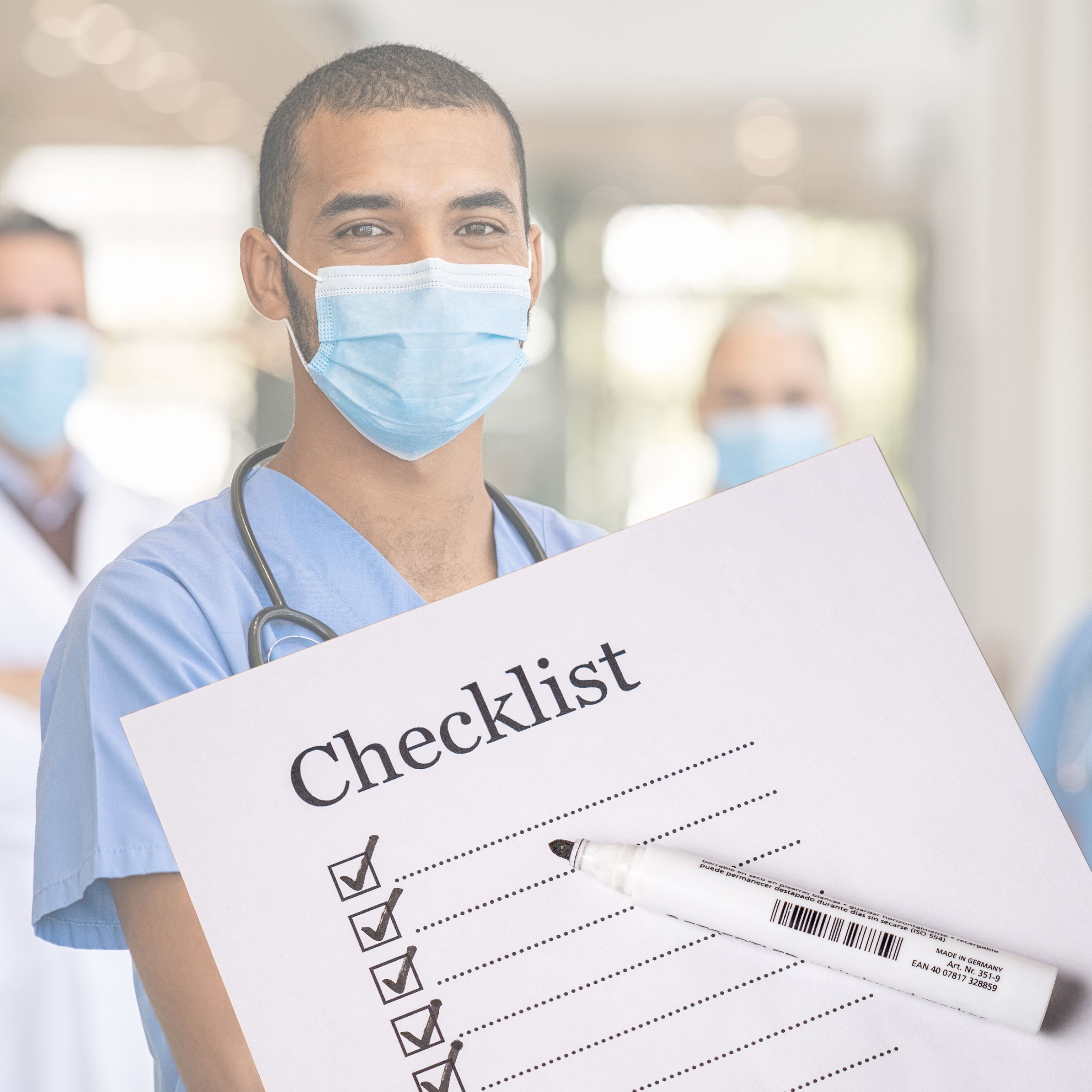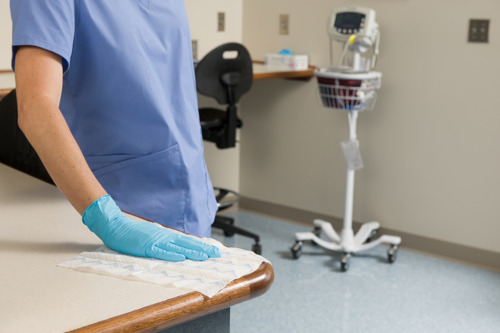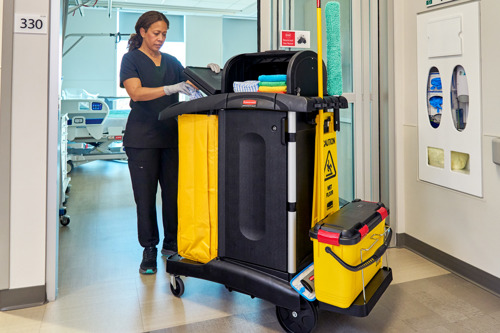
Maintaining a spotless environment in a hospital isn't just about appearances—it’s a vital part of infection control and patient care. According to the Australian Commission on Safety and Quality in Health Care (ACSQHC), around 165,000 healthcare-associated infections (HAIS) occur each year. That’s a major reminder of why a hospital cleaning checklist is crucial to the daily operations of any healthcare facility.
Proper cleaning procedures, especially on high-touch surfaces like bed rails, door handles, and light switches, help reduce the risk of infection. These practices also improve outcomes across intensive care units, operating rooms, and outpatient wards.
At Rubbermaid Commercial, we understand that effective hospital cleaning involves using the right cleaning equipment, disinfectant products, and cleaning solutions to protect patients, staff, and visitors. This guide to essential steps for patient room and bathroom care will walk you through best practices for routine cleaning, deep cleaning, and terminal cleaning.
In every healthcare facility, high touch surfaces are a top priority in any hospital cleaning checklist. These surfaces—like bed rails, light switches, door handles, and arm rails—are frequently contacted by patients, visitors, and healthcare workers. Without regular cleaning and disinfecting, such areas become hotspots for the spread of healthcare-associated infections.
Cleaning tasks must focus on patient care areas including operating rooms, intensive care units, outpatient wards, and isolation wards. Surfaces like nurse call buttons, over-bed tables, and seat covers also require special attention during routine cleaning and terminal cleaning. Proper cleaning solutions and disinfectant products must be used alongside colour-coded microfibre cloths and mops to reduce cross-contamination.
Each cleaning procedure should follow set guidelines, with cleaning staff equipped in appropriate PPE. Cleaning frequency depends on the patient zone’s risk level and occupancy, with daily cleaning required for most patient rooms and waiting areas.
A structured hospital cleaning checklist ensures every room, surface, and fixture is properly cleaned and disinfected. Thus, it reduces the risk of healthcare-associated infections among patients, visitors, and healthcare workers. Without clear cleaning schedules and set cleaning procedures, critical areas like high touch surfaces, waiting areas, operating rooms, and intensive care units could easily be overlooked.
A good checklist sets clear expectations for the cleaning staff. This includes choosing the right cleaning solutions and disinfectant products and ensuring proper personal protective equipment is worn. It also defines cleaning frequency for different zones—like daily cleaning for patient care areas, spot cleaning for waiting areas, and deep cleaning for isolation wards and outpatient wards.
Using a hospital housekeeping checklist also standardises tasks. It’s also vital for documenting work or even a digital signature system to track performance and compliance.
Having the right cleaning equipment is the foundation of a strong hospital cleaning checklist. We’ve developed a range of best-in-class solutions that are purpose-built for the challenges of hospital cleaning. Our products are designed to deliver efficient, hygienic, and compliant results, helping your cleaning staff manage everything from high touch surfaces to body fluids in patient care areas, outpatient wards, and intensive care units. Here's a closer look at the essentials your team needs for effective hospital sanitation.
Our Rubbermaid HYGEN™ disposable microfibre cloths and mops feature built-in scrubber technology and a 99.9% microbe removal claim — critical for high-risk zones like ICUs, isolation wards, and ERs. They deliver streak-free results and deep cleaning power across touch surfaces like bed rails, door handles, and light switches, while being fully compatible with quat disinfectants and safe for bleach use.
These versatile tools are ideal for cleaning in occupied patient rooms, discharged patient rooms, operating rooms, nurses’ stations, and even imaging areas like MRI/X-ray stations. By integrating HYGEN™ cloths and mops into your hospital housekeeping checklist, you can maintain high standards across all cleaning tasks — from spot cleaning to full deep cleaning — and help reduce the risk of healthcare associated infections.

The HYGEN™ Microfibre Charging Mop Bucket, combined with our HYGEN™ Damp Mops and Quick-Connect handles, makes it easy to soak and manage cleaning solutions without cross-contamination properly. It supports fast, effective coverage of large surface areas like patient room floors, wet floors, and shower cleaning zones.
This system improves efficiency by helping cleaning staff automatically generate ready-to-use mop heads in seconds. It streamlines daily and routine cleaning schedules while enhancing infection control outcomes. It's an essential tool for regular and intensive terminal cleaning requirements.

Rubbermaid offers a full range of janitorial cleaning carts to support comprehensive hospital sanitation programs:
Traditional Janitorial Cleaning Cart: This is Perfect for daily cleaning and lightweight cleaning tasks across waiting areas and patient zones.
High-Capacity Janitorial Cleaning Carts with Doors and Hood: Designed for managing medical waste, paper towels, sharps disposal, and disinfectant products securely across multiple rooms.
Executive Janitorial Cleaning Cart: Ideal for sensitive environments like high risk areas, isolation wards, and intensive care units, where controlling access to cleaning supplies and waste materials is critical.
All carts can be customised to carry appropriate PPE, hand sanitisers, and cleaning equipment and ensure safe storage for used linen and medical waste until proper disposal.
The Rubbermaid HYGEN™ Flexi-Frame allows cleaning staff to reach tight corners and around odd-shaped equipment efficiently without missing a spot. It's handy for spot-cleaning areas like under beds, behind toilets, and around bulky hospital machines.
Meanwhile, the Rubbermaid PULSE Mop Kit enables fast, targeted floor and surface cleaning with an onboard reservoir for cleaning solutions—perfect for shower cleaning, body fluid spills, or urgent sanitisation needs without the downtime of a full mop bucket refill.
Rubbermaid’s PVC-coated mesh headband mops provide durable, high-absorbency performance for larger areas like operating rooms and patient care areas. These mops are designed to handle heavy-duty cleaning tasks efficiently, supporting the safe removal of soil, pathogens, and moisture from critical areas. They’re especially useful for damp mopping after a terminal cleaning procedure when preparing cleaned patient rooms for new admissions.
Cleaning patient rooms thoroughly is vital for infection prevention and patient well-being. This checklist, consistent with the AHE Practice Guidance for Healthcare Environmental Cleaning, outlines each step from preparation to final floor care.
Observe risk level and isolation status.
Stock janitorial cleaning cart with all required supplies.
Don personal protective equipment (PPE).
Perform hand hygiene.
Use a damp green microfibre cloth folded using the 8-side method.
Start high and work downwards using a consistent pattern.
Wet cloths via charging bucket, pour method, or dip and wring.
Use a fresh damp green microfibre cloth.
Clean over-bed table (surface, base, pedestal, casters).
Damp-wipe chairs (seat, back, legs, rungs).
Wipe light fixtures and wall-mounted items.
Use a fresh green microfibre cloth.
Wipe down visually dirty walls, mirrors, or signage.
Focus on high-touch areas like near door sills.
Use a green microfibre cloth.
Clean doorknobs, hinges, kickplates, and push plates.
Never reach inside containers.
Close liners before removal and place in the appropriate waste stream.
Wipe bins (foot pedals, interior/exterior lids) with an approved disinfectant.
Insert new liners.
Use a green microfibre cloth.
Clean side rails, bed frame, footboard, and headboard.
If unoccupied, wipe the mattress thoroughly.
After disinfecting the patient room, continue into the bathroom. Bathrooms are high-risk areas where proper cleaning prevents the spread of harmful pathogens. The following steps are aligned with best practices from AHE’s environmental cleaning guidance.
Pour toilet bowl cleaner directly into the bowl water.
Use the bowl brush to scrub all surfaces, including under the rim.
Allow cleaner to dwell while completing other bathroom tasks.
Spray cleaning solution on tiled walls and start from the top, working downward.
Use a damp microfibre pad to scrub surfaces.
Wipe fixtures such as showerhead, taps, and handrails using a yellow microfibre cloth.
Clean shower rods and curtains thoroughly.
Use a lightly moistened blue glass microfibre cloth.
Wipe from top to bottom, removing fingerprints and smudges.
Refill items like soap, toilet paper, paper towels, folded towels, and liners.
Safely remove waste — tie bags securely and avoid contact with sharp objects.
Flush toilet and exit the bathroom once tasks are complete.
Visually inspect ceiling vents, doorframes, and lights.
Use a damp duster on hard-to-reach areas like top of mirrors or corners.
Use a yellow microfibre cloth for general sink and counter cleaning.
Use a blue cloth for polishing metal fixtures and bright surfaces.
Wipe exposed piping and inside sink cabinet doors.
Wipe seat, flush handle, and porcelain exterior (top, front, behind, and under bowl) using a yellow microfibre cloth.
Dispose of the cloth after use—never reuse across different areas.
Check for visible dirt or stains.
Use a yellow microfibre cloth to clean only affected areas.
Wipe grab bars and surrounding wall sections.

Proper floor cleaning is essential in reducing pathogen spread — especially in hospital environments where studies have found Clostridioides difficile (C. diff) on over 50% of sampled floor sites. Follow these final cleaning steps to maintain safety and hygiene in patient zones.
Check for stuck-on debris or obstructions. Use a scraper if necessary.
Start with a green microfibre dust mop in the farthest corner of the room.
Work backward toward the entrance, keeping the dust mop on the floor.
Dust under beds and furnishings without disturbing the patient.
Push dust toward the restroom door, then enter and dust mop the bathroom.
Sweep collected debris into a dustpan and dispose into the janitorial cart's waste bin.
Place a wet floor sign at the doorway before starting.
Use a blue microfibre damp mop pad, properly charged with cleaning solution.
Begin in the far corner of the room and mop backward toward the entrance and bathroom.
Mop under beds, furnishings, and around corners thoroughly.
In the bathroom, mop under all fixtures including behind toilets and sinks.
Exit the bathroom and patient room while continuing to mop backward.
Dispose of the used mop pad into the dirty linen bag — only one mop per room.
Notify the patient that cleaning is complete (if room is occupied).
If the floor is dry, remove the wet floor sign. If not, leave it and retrieve later.
Perform hand hygiene and safely doff PPE.
If the room is now vacant, inform your supervisor or the nurse’s station that it’s ready for admission.
Maintaining a clean, safe, and welcoming environment is non-negotiable in any healthcare facility. With the right hospital cleaning checklist, consistent cleaning procedures, and high-performance cleaning solutions, hospitals can protect every person who walks through their doors.
Ready to take your hospital cleaning processes to the next level? Explore Rubbermaid Commercial’s range of industry-leading cleaning solutions built specifically for healthcare needs.